A little thunder, a spattering of gentle rain on dry soil and leaves, the fragrance of kulae puttu steaming gently in a sekala. That, for me, is the essence of May in Coorg. Pre-monsoon showers have appeared and, with jackfruit season in full swing in India, I’m sure there’s kulae puttu being made in homes across Coorg. Sigh!
My grandmother made kulae puttu in industrial quantities to cater to the hordes of grandchildren who just couldn’t get enough of them. Well, those of us who liked jackfruit, that is. Fortunately, these luscious, sweet steamed cakes are almost as easy to make as to make disappear.
Kulae puttu is steamed in a leaf wrapper, which makes it even more alluring. As with anything cooked in a wrapper, opening up that fragrant parcel is one of life’s sweet pleasures. Again, unless of course, you don’t like jackfruit!
Jackfruit are loosely classed into barké and kulae varieties. The former are the kind with crisp flesh, while kulae chekké tends to be stringy and very sticky. The latter is the kind generally preferred for making kulae puttu.
The pods are ground, and a thick extract obtained by straining out the fibrous part. If you can’t get kulae chekké, the other kind will do just fine as well. Just grind the ripe pods with enough water to make a thick paste. Kulae puttu is usually made from ripe jackfruit, but a banana version is popular too, and delicious in its own way.
Kulae puttu
Sweet steamed cakes of jackruit or banana
- 300 gms raw rice, soaked for 6-8 hours
or the equivalent amount of fine thari, soaked for 1 hour
You can also use suji/rava (or try cream of wheat or a soft wheat semolina) but the texture will be more grainy than that of kulae puttu made with soaked and ground rice - 500 gms jackfruit pulp or ripe banana pulp
- 1/2 coconut – 1/4 to be grated and the rest sliced into thin slivers about 1 cm long
- 1/4 tsp baking soda (optional). It makes for a less dense cake, but I prefer the version without
- 200 gms jaggery or to taste (check how sweet the jackfruit or banana is before adding more)
- If you’re using banana pulp, add a little ground cardamom to the mixture
- A pinch of salt
- 25 pieces of banana leaf, of about 8″x 6″
Banana leaves need to be heated briefly to soften them and make them flexible enough to fold without breaking. This can be done by pressing them on a heated griddle, passing them gently over a flame, or, as I do, tossing them in a hot oven briefly!
Grind the soaked rice to a smooth paste with a little water.
Combine the ground rice with the jaggery, jackfruit pulp, coconut, salt, and baking soda if you’re using it. Mix thoroughly. You should have a soft, moist batter that is thick enough to spoon into the banana leaves without being too runny.
Place two tablespoons of the batter in the centre of a banana leaf wrapper and fold gently into a rectangular parcel. Have your sekala ready with water at a simmer and layer the parcels in as you prepare them. When they’re all done, cover and steam on medium-high for about 30 minutes.
Remove the lid of the steamer and allow them to cool a little before tucking in. Kulae puttu tastes wonderful with a dab of fresh butter or ghee. Day old kulae puttu tastes delicious seared in a little ghee and dished up for breakfast or as a teatime treat.
Wrapping it up
For many years, I thought kulae puttu was named for the variety of jackfruit usually used to make it (kulae chekké). While banana leaves are most commonly used as wrappers now, I’d heard that there was another leaf from the kooelé (Schumannianthus virgatus) plant that was used traditionally. Well, of course, I had to see what that was about! I got hold of some kooelé leaves and cooked a number of things in them.While they add no fragrance to the food unlike banana or turmeric leaves, I can see why these leaves were so useful in times past. They’re large and extremely sturdy. So sturdy in fact, they were woven on light bamboo frames to make a protective rain cape for use in the pounding monsoon rain!

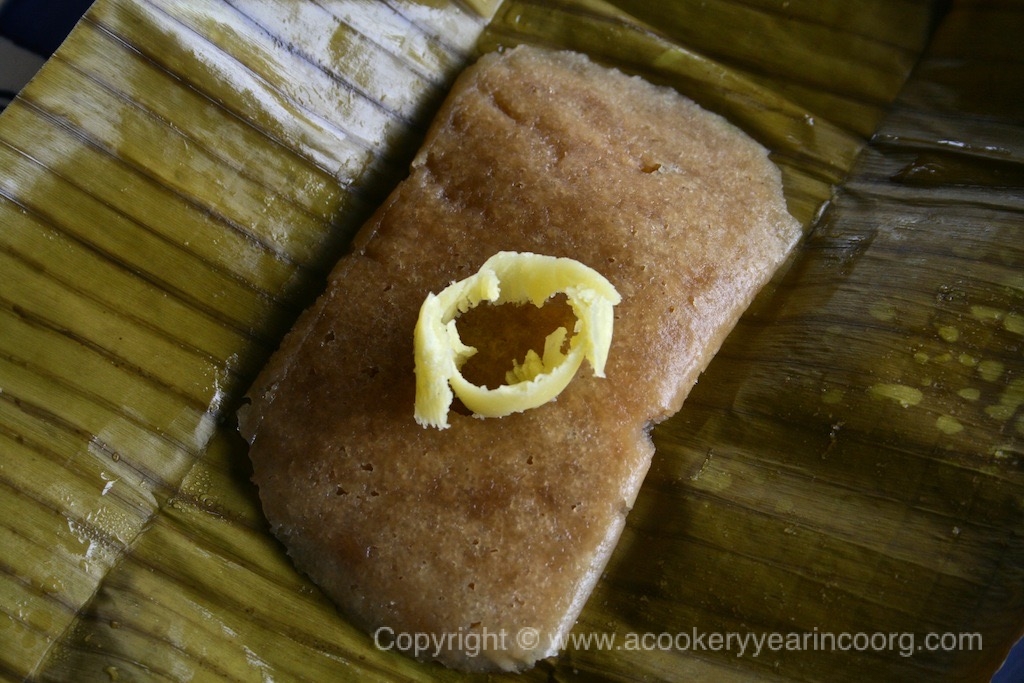
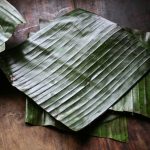
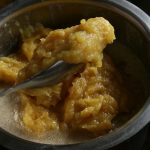
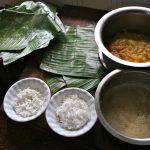
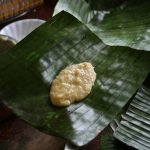
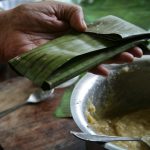
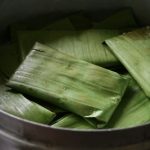
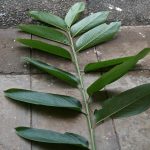
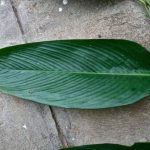

OK, I’ll admit right off the bat that I am not a fan of ripe jackfruit – but I do believe I’d eat these!
Fascinating note about the Schumannianthus…wonder if it was used in the same way in other parts of South Asia..
Thanks for yet another beautifully photographed and documented post! I am hoping that this blog is a rough draft for a book.
Thanks, Wildflower!Book? mmmhmm 😉
The Schumannianthus leaves are so remarkably strong, I can’t imagine that they wouldn’t have found their way into common use anywhere they were available. I’d love to know more too. Have to say though,this is one of those instances where the stand-in banana leaf brings a whole lot more to the kulae puttu- the end result is much more fragrant and delicate.
As you probably know, in Kerala, they make two versions of this steamed jackfruit sweet- one with fresh jackfruit and another with a jackrfuit jam (chakka varatti).Using preserves in this way opens up a range of possibilities, don’t you think, particularly for the jackfruit averse?!
My grandmother made amazing banana jam and pineapple jam but I cannot recall her ever making a jackfruit jam. I need to check on that.